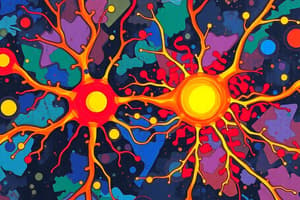Podcast
Questions and Answers
Which type of sensory receptors are responsible for converting external energy into electrochemical signals?
Which type of sensory receptors are responsible for converting external energy into electrochemical signals?
- Neural receptors
- Environmental receptors
- Mechanical receptors
- Sensory receptors (correct)
Pain is classified as a type of mechanical sensation.
Pain is classified as a type of mechanical sensation.
False (B)
What is the process called when there is a progressive loss of response to a sustained stimulus?
What is the process called when there is a progressive loss of response to a sustained stimulus?
Adaptation
The sense of ________ is primarily linked to chemical receptors for detecting substances in contact with the tongue.
The sense of ________ is primarily linked to chemical receptors for detecting substances in contact with the tongue.
Match the following sensory systems with their respective stimuli:
Match the following sensory systems with their respective stimuli:
Which statement correctly describes 'labeled lines' in sensory systems?
Which statement correctly describes 'labeled lines' in sensory systems?
Spatial properties of stimuli are communicated by labeled lines in the nervous system.
Spatial properties of stimuli are communicated by labeled lines in the nervous system.
What type of sensation is primarily produced by injury or damage to tissue?
What type of sensation is primarily produced by injury or damage to tissue?
The sense associated with the detection of head movement and orientation is called ________.
The sense associated with the detection of head movement and orientation is called ________.
Which of the following is NOT classified as a sensory system?
Which of the following is NOT classified as a sensory system?
What type of receptors display little or no adaptation?
What type of receptors display little or no adaptation?
Phasic receptors do not adapt to constant stimuli.
Phasic receptors do not adapt to constant stimuli.
What is congenital analgesia and what causes it?
What is congenital analgesia and what causes it?
The primary sensory pathway for touch signals is called the _____ column system.
The primary sensory pathway for touch signals is called the _____ column system.
Match the TRP channels with their sensitivity:
Match the TRP channels with their sensitivity:
Which neurotransmitter is released during descending pain modulation?
Which neurotransmitter is released during descending pain modulation?
Itch fibers are primarily C-fibers that can be affected by histamine.
Itch fibers are primarily C-fibers that can be affected by histamine.
Describe the pathway for first order neurons in the anterolateral system.
Describe the pathway for first order neurons in the anterolateral system.
Touch stimuli are ultimately perceived in the contralateral _____ cortex.
Touch stimuli are ultimately perceived in the contralateral _____ cortex.
What does the term 'labeled lines' refer to in sensory processing?
What does the term 'labeled lines' refer to in sensory processing?
Flashcards are hidden until you start studying
Study Notes
Sensory Reception
- Sensory receptors are specialized cells designed to detect specific forms of energy.
- Upon activation by an external stimulus, sensory receptors convert this energy into an electrochemical signal for the nervous system to understand.
Classification of Sensory Systems
- Mechanical: Touch, pain, hearing, vestibular, joint, muscle
- Visual: Seeing
- Chemical: Smell, taste, common chemical (CO2, pH, osmotic pressure), vomeronasal (pheromones)
- Electrical: Electroreception
- Thermal: Cold, warmth
- Magnetic: Magnetoreception
Sensory Systems Sensitivity
- Each sensory system is designed to respond to a specific range of stimuli.
Differentiating Between Stimuli
- Labeled lines: Distinct neurons are dedicated to conveying unique sensory experiences.
- This allows discrimination between different sensations because they are communicated through different neuronal pathways.
Signal Transduction
- The process of converting a stimulus into an electrochemical signal.
- This is the process by which sensory receptors translate external stimuli into a language understood by the nervous system.
Stimulus Coding
- Stimulus Intensity: A stronger stimulus generates more action potentials in the sensory neuron.
- Stimulus Location: Spatial information about a stimulus is encoded by labeled lines carrying signals from different locations on the body.
Adaptation
- Tonic receptors: Show little or no adaptation to a sustained stimulus, providing continuous information.
- Phasic receptors: Adapt quickly to a sustained stimulus, encoding changes in stimulus intensity rather than its constant presence.
Sensory Suppression
- Accessibility of sensory input can be controlled:
- Accessory structures: Physical mechanisms like closing your eyes can limit input.
- Top-down (hierarchical) neural control: The brain can filter or suppress sensory input.
Levels of Sensory Processing
- Sensory information is processed in a hierarchical manner, with increasing levels of complexity.
- Information travels from sensory receptors to the spinal cord, then to the brain, where it is further processed in different areas dedicated to specific sensory modalities.
Receptive Fields
- A receptive field is the specific area of the body that can trigger an action potential in a sensory neuron.
- The size and shape of receptive fields vary depending on the type of sensory receptor.
Touch
- This sense relies on a variety of sensory receptors in the skin, which respond to different mechanical stimuli.
- These receptors are responsible for detecting pressure, texture, vibration, and temperature.
Fibers Linking Receptors to the Nervous System
- Sensory receptors communicate with the nervous system through specialized nerve fibers.
- The type of fiber carrying the signal determines the speed and quality of the touch information conveyed to the brain.
Signal Transduction in Touch
- Mechanoreceptors: Convert mechanical pressure into electrical signals.
- Thermoreceptors: Detect changes in temperature.
- Nociceptors: Activated by noxious stimuli, triggering pain signals.
Dorsal Column Pathway
- This pathway carries touch information to the brain:
- First order neurons: Synapse in the ipsilateral dorsal column nuclei (gracile and cuneate).
- Second order neurons: Synapse in the contralateral thalamus.
- Third order neurons: Synapse in the contralateral somatosensory cortex.
Pain
- A complex sensory experience caused by the activation of nociceptors, signaling tissue damage or potential harm.
Components of Pain
- Sensory-discriminative: Location, intensity, quality of the painful stimulus.
- Motivational-affective: The unpleasantness and emotional response to pain.
- Cognitive-evaluative: The interpretation and meaning attributed to pain.
Signal Transduction in Pain
- Nociceptors: Free nerve endings with specialized ion channels that respond to noxious stimuli, such as extreme temperatures, pressure, or chemicals.
TRP Channels
- Transient Receptor Potential (TRP) channels: A family of ion channels involved in pain perception.
- TRPV1: Activated by capsaicin (the compound that makes chili peppers hot), as well as by heat.
- TRPM3: Activated by very high temperatures.
- TRPM8: Activated by cold temperatures.
People Without Pain
- Congenital analgesia: A rare condition where individuals lack the sensation of pain.
- This can be caused by mutations in genes responsible for pain signaling, such as:
- SNC9: Loss-of-function mutation.
- Na+V1.7: Critical for pain signal conduction.
Anterolateral System
- This pathway transmits pain information to the brain:
- First order neurons: Synapse in the ipsilateral dorsal horn of the spinal cord.
- Second order neurons: Synapse in the contralateral thalamus.
- Third order neurons: Synapse in the contralateral somatosensory cortex.
Descending Pain Modulation
-
The brain can modulate pain signals:
- First order neurons: Synapse in the periaqueductal gray.
- Second order neurons: Synapse in the raphe nucleus.
- Third order neurons: Synapse in the spinal cord grey matter.
-
This system releases neurotransmitters like serotonin and opioids, which can suppress pain signals in the spinal cord.
Itch
- This sensation is often associated with skin irritation, and it is mediated by a separate sensory pathway from pain.
- Itch fibers: C-fibers that are sensitive to histamine and chloroquine-like substances.
- Terminate in the pons.
Emotional Pain and Physical Pain
- Both physical and emotional pain can activate similar brain regions, suggesting that they share underlying neural mechanisms.
Practice Questions
- Signal transduction: This is the conversion of stimulus energy into a language understood by the nervous system. Stimuli can be transduced through different mechanisms like mechanical deformation, temperature change, chemical binding, or light absorption.
- Pathways for Touch and Pain:
- Touch: Information travels through the dorsal column pathway, where neurons synapse in the dorsal column nuclei, thalamus, and finally reach the somatosensory cortex.
- Pain: Information travels through the anterolateral system, where neurons synapse in the spinal dorsal horn, thalamus, and somatosensory cortex.
- Labeled lines: Each sensory neuron is dedicated to carrying information about a specific type of stimulus from a particular location on the body. This arrangement helps the brain distinguish between different sensations and pinpoint their origin.
- Meissner corpuscles, Ruffini endings, Pacinian corpuscles, Merkel discs, free nerve endings: These receptors differ in their location, structure, and sensitivity:
- Meissner corpuscles: Located in the superficial layers of the skin, respond to light touch and vibration.
- Ruffini endings: Located in the deeper layers of the skin, respond to stretching and sustained pressure.
- Pacinian corpuscles: Located deep in the skin and other tissues, respond to vibrations and rapid pressure changes.
- Merkel discs: Located in the epidermis, respond to pressure and texture.
- Free nerve endings: Are found throughout the skin and other tissues, respond to pain, temperature, and light touch.
Studying That Suits You
Use AI to generate personalized quizzes and flashcards to suit your learning preferences.




